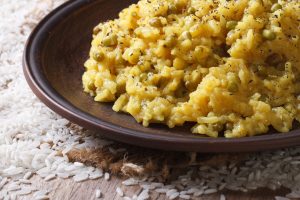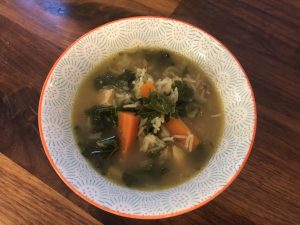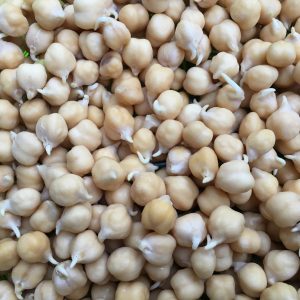During our Autumn cleanse, which is soon coming to an end, we sampled the following recipes to understand how our diet can balance or imbalance the doshas.
Here are some recipes you can try which are perfect for this time of year.
Kitchari
 kitchari is an Ayurvedic staple. A nourishing mix of mung beans and rice, easy on the digestion and suitable for all doshas. We have Kitchari during the mono-diet phase of the cleanse, but its a great dish to have when your digestion’s is a little upset. You can add vegetables to make it a nourishing, satisfying dish. Here we have created a spice blend to suit each of the doshas. Quantities here are enough to make a jar of spices you have on hand to add to food when you are cooking.
kitchari is an Ayurvedic staple. A nourishing mix of mung beans and rice, easy on the digestion and suitable for all doshas. We have Kitchari during the mono-diet phase of the cleanse, but its a great dish to have when your digestion’s is a little upset. You can add vegetables to make it a nourishing, satisfying dish. Here we have created a spice blend to suit each of the doshas. Quantities here are enough to make a jar of spices you have on hand to add to food when you are cooking.
Ingredients:
Pitta Balancing Spice Mix:
- 2tbs Fennel seeds
- 2tbs Cumin seeds
- 2tbs Coriander seeds
- 1tbs fenugreek seeds
- Seeds of 10 cardamon pods
- 1/2tsp Saffron strands
- 1tbs cinnamon powder
Kitcahri:
75g yellow mung dhal
75g basmati rice
Thumb sized piece of grated fresh ginger
2 tbs unsweetened shredded coconut – desiccated coconut
3 tbs ghee
1/2 tsp rock salt
The how to:
For each recipe heat the oil and add the dry spices, garlic, ginger (where specified). Add mung dahl and 250mls water. Simmer for 5 mins and add the rice and 500mls water. Simmer until all ingredients are soft.
For the pitta recipe, finish with desiccated coconut.
Why it’s so good
Kitchari provides an easy to digest, nourishing meal so it’s perfect if your digestion is a little out of balance. The suggested spices will help support the digestive fire for each of the doshas.
Vegetables can also be added to make it a really satisfying meal. You could try: diced courgette, spinach, green beans, asparagus…
Balancing the Doshas
The spice mix for pitta will help to cool excess heat. Pitta dosha tends towards tikshnagni, meaning the digestive fire is burins too strongly. If this is the case you may feel it in the form of acid indigestion.
Vata Spice Mix
- 2tbs Fennel seeds
- 2tbs Coriander seeds
- 2tbd cumin seeds
- 1tbs ground turmeric
- 2tbs group ginger
- 1tsp asafoetida (hing)
- 2tsp rock salt
Mung Dal Kitchari – Vata
75g basmati rice
75g yellow split mung dhal 3 tbs ghee
Thumb size piece of fresh grated ginger
1 clove garlic
2tbs of Vata spice mix.
Kapha Spice Mix
- 2tbs Coriander seeds
- 2tbs cumin seeds
- 2tbs mustard seeds
- 1tbs ground ginger
- 1tbs ground turmeric
- 1tsp ground cloves
- 2tsp ground black pepper or pippali
- 1tsp chilli powder
Mung Dhal Kitchari – (Kapha)
- 75g yellow mung dhal
- 75g basmati rice
- 1 tbs ghee
- Thumb size piece of fresh ginger.
- 4 bay leaves
- 2tbs Kapha spice mix 1/2 tsp salt
- 750mls water
Brown Rice Vegetable Soup
Ingredients:
Makes enough for 4
- 2 Tbs Vata Spices. See Kitchari recipe
- 100g Rice: basmati or brown basmati.

- 2 sticks celery
- 2-3 carrots
- 1 potato
- 750mls Bone broth. stock or water
- Bunch fresh parsley
- Sprig fresh rosemary
- Bunch fresh thyme
- Small bunch fresh oregano
- Small bunch fresh dill
- 1-2 tbs dried fenugreek leaves.
- 1 tbs Olive oil or ghee
- Salt and pepper to taste.
The how to:
Soak the rice overnight or 8 hours. Chop carrots and celery keeping them quite chunky. Sauté in oil or ghee and add the spices for 10mins.
Add rice and stock. Cook slowly on a low heat for 1.5 – 2 hours, alternatively transfer it to a slow cooker and cook on a low heat for 6-8 hours.
Or, add any vegetables you fancy. Think green and seasonal. Here I’ve used savoy cabbage.
Why it’s so good
Pre-soaking the rice makes it much easier to digest. The fresh, green herbs add the alkalising, bitter taste which we generally lack in our diet. If you don’t have fresh herbs use dried.
Using bone broth not only adds depth of flavour, but provides easy to digest protein, minerals and can help strengthen the immune system.
Balancing the Doshas
As it is, it is balancing for Vata and Pitta.
To make it a little lighter for Kapha you may want to omit the potato.
Chickpea Coconut Curry
Cooling and nourishing. Perfect for Pitta and Vata Dosha.
Ingredients:
- 1tsp (2tbs) Coriander seeds
- 1tsp (2tbs) fennel seeds
- 1tsp (2tbs) cumin seeds
- 1/4 tsp (1tbs) ground turmeric
- 1tsp (2tbs) group ginger
- Pinch (1tsp) asafoetida (hing)
- 2tsp rock salt
- 1/2 tsp fenugreek seeds for the chickpeas.
- 250g Soaked chickpeas
- 1/2 tin /1/2 block coconut milk.
- 2 cloves garlic
- Thumb size piece ginger
- 1 courgette
- Bunch spinach
The how to:
The prep involves soaking and sprouting the chickpeas to make them more digestible for Vata dosha. Soak overnight and allow to sprout on a plate or a sprouter.

Boil the chickpeas with 1/2 tsp on fenugreek seeds until soft.
Heat ghee in a pan and add Vata balancing spices. Cook for a few minute. Add ginger and garlic. Add the chickpeas and 1/2 tin coconut milk or 1/2 block creamed coconut. Simmer for 10 mins add chopped spinach and sliced courgettes. Cook for a further 10-15mins. Serve with boiled basmati rice.
Why it’s so good
For many people, chickpeas can aggravate the digestion causing gas and bloating, especially for Vata dosha. Soaking, sprouting and adding asafoetida and fenugreek helps eliminate this.
Balancing the Doshas
For Kapha dosha don’t add the coconut milk and make it a little dryer.
